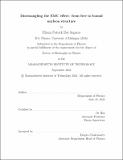| dc.contributor.advisor | Hen, Or | |
| dc.contributor.author | Segarra, Efrain Patrick Dai | |
| dc.date.accessioned | 2023-05-17T17:41:12Z | |
| dc.date.available | 2023-05-17T17:41:12Z | |
| dc.date.issued | 2022-09 | |
| dc.date.submitted | 2023-05-16T17:06:33.519Z | |
| dc.identifier.uri | https://hdl.handle.net/1721.1/150765 | |
| dc.description.abstract | Deep inelastic scattering experiments using electron beams on fixed targets allow for the study of the structure of nucleons. While the structure of the free proton has been well measured, the free neutron structure and the modification of nucleon structure in the nuclear environment, the EMC effect, remain open questions. Studies suggest that the EMC effect may arise due to strongly-interacting nucleon-nucleon systems, referred to as short-range correlations. The BAND experiment at the Thomas Jefferson National Accelerator Facility seeks to probe the bound proton structure when in a strongly-interacting state, using spectator-tagged deep inelastic scattering. This thesis presents the results of the BAND experiment, demonstrating the proton is modified when strongly-interacting with the spectator neutron in deuterium. This thesis also explores efforts to describe inclusive and tagged deep inelastic scattering data within a uniform theoretical framework to explore nucleon structure modification effects and extract the free neutron structure. | |
| dc.publisher | Massachusetts Institute of Technology | |
| dc.rights | In Copyright - Educational Use Permitted | |
| dc.rights | Copyright MIT | |
| dc.rights.uri | http://rightsstatements.org/page/InC-EDU/1.0/ | |
| dc.title | Disentangling the EMC effect: from free to bound nucleon structure | |
| dc.type | Thesis | |
| dc.description.degree | Ph.D. | |
| dc.contributor.department | Massachusetts Institute of Technology. Department of Physics | |
| mit.thesis.degree | Doctoral | |
| thesis.degree.name | Doctor of Philosophy | |
